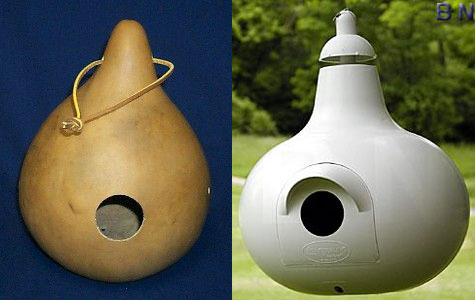
There are two different styles of purple martin houses in wide use, the “gourd” and the “apartment house.”
Gourds
Gourds were used by Native Americans and natural gourds remain a popular house choice.
Plastic gourds in a variety of styles have also become popular. Some of the plastic gourds are a two-piece design that make it easy to clean at the end of the nesting season or to remove unwanted nesting species.
If you elect to use gourds for nest boxes, plan on starting with a minimum of 8-10 gourds. Purple Martins nest in colonies and fewer gourds may affect your chances of attracting martins.
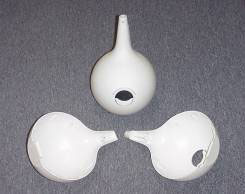
Some plastic gourds can be snapped apart for easy cleaning. Plastic gourds should be white, not painted purple. Darker colors can lead to high nesting area temperatures.
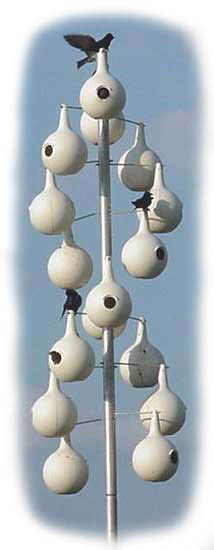
Gourds are usually pole mounted. Poles and mounting arms are available for producing different and attractive patterns.
Purple Martin Apartment House
There are many styles of the “purple martin apartment house.” The houses may be plastic, metal or wooden.
One, two and multiple story versions are available. If you are just starting out, it may be advisable to avoid the larger houses (keep the 8-10 minimum in mind). House sparrows and starlings are aggressive interlopers and a large house can be more difficult to manage until the martin colony has become established.
The same martins will be returning to your house year after year and you can increase the number of individual apartments as the size of the colony grows.
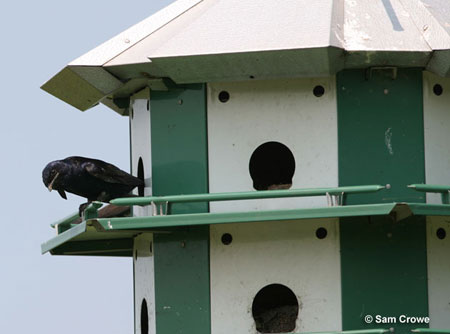
Both the gourd and the apartment are about equally successful in attracting purple martins and in maintaining the colony. Some people believe that the gourds attract fewer house sparrows and starlings which are less adept at entering the gourds as they sway in the wind.
The Purple Martin Conservation Association reported in the Purple Martin Update {Vol. 8(4)} that some data suggests that natural gourds have a higher nesting success rate than the aluminum houses, with wooden houses falling somewhere in the middle.
When purchasing a wooden or aluminum martin house be sure the nesting box itself is at least 6″x 6″ in size and that each nest area can be easily accessed. Larger and deeper compartments are probably desirable. Compartments 6 inches wide and up to 12 inches deep provide more room and encourage larger clutch sizes. They may also provide some protection from great-horned owl attacks.
The inside of a nesting box can become extremely hot in the summer.
Therefore, only white or other bright reflective colors should be used. White will reflect the sunlight and heat. A darkly colored martin house will heat up significantly and make the interior temperature unbearable.
Be sure your purple martin house can be easily lowered and raised. Some wooden houses are very attractive but also very heavy and can be difficult to raise and lower. The best types have pulley systems that raise and lower the house vertically while the pole remains fixed. Poles that lower the house to the side prevent the house from being inspected during the nesting season.
Management of the nesting boxes is critical to their success. Select a house design that makes it easy to access the inside of each nesting chamber. More information on managing the colony is available in both the “Care” and “Attracting Purple Martins” sections.
Location
The location of your purple martin house is critical to your success in attracting martins. These are some of the key points:
1. Locate the martin house within 100 feet of your house. Human activity tends to provide protection for predators and houses placed too far away from human activity are less successful than those placed closer to a home or residence.
2. Have a 40 foot area of clear “fly space.” Provide easy access to the house from several directions. Trees, buildings or wires located to close too the house will make access difficult. Do not locate near trees or wires that are within jumping range of squirrels or other predators.
3. The martin houses should typically be placed about 15 feet high. Depending on the terrain, nearby trees or shrubs, etc., it can be necessary to raise the houses even higher for adequate clearance.
Open for Business
Deciding when to put up (or open up) your martin house is an important factor in attracting martins. There are two factors to consider in determining the answer to this question.
1. For established sites:
If you had an established colony the previous year the same birds will return. The first arrivals are often referred to as scouts and try to return to the same nesting area as the previous year. The Purple Martin house should be up and open just before the first scouts arrive in your area. For example, martin houses should be up the first of February in Texas but not until May in the northern U.S. and Canada.
Houses that are up and open before the scouts arrive will attract House Sparrows and starlings. The martin house should be monitored at all times for signs of these species and any nesting materials removed.
2. For new sites:
If you are establishing a new colony, you will be trying to attract birds that want to nest for the first time. These first time nesters arrive about 4 weeks after the scouts arrive. You should, therefore, open your new martin houses about 4 weeks after the scout arrival dates shown on the map below. Again, the goal is to minimize the time available to starlings and house sparrows to become attracted to the martin house.
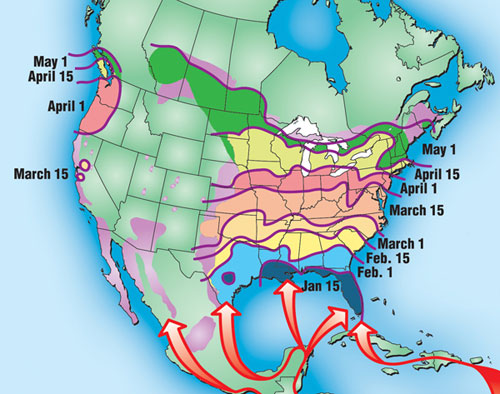
Arrival dates of Purple Martins. If you have an existing martin colony, open the house near the dates shown. If you have a new martin house, open it 3-4 weeks after the dates shown. Map courtesy of the Purple Martin Conservation Association.
Replacing Existing Housing
The same martins return each year and may abandon the site if the housing they are used to has been moved or replaced.
To replace an active house, place the new housing near the housing you want to remove, and give the martins an entire season to adjust.
It is best not remove the active house until some of the martins have accepted and bred in the new housing.
Once martins have nested in the new housing, you can remove or replace the old house. If you have several active houses you can replace a house between seasons.

